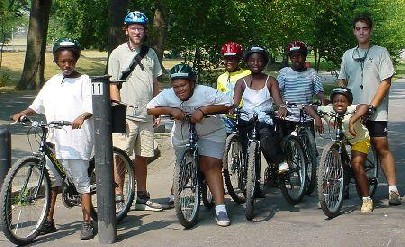Youth bike skills decline
From the Nashville City Paper
By Bill Harless, bharless@nashvillecitypaper.com
April 05, 2005
When Walk/Bike Nashville, a local bicycling and pedestrian group, surveyed about 100 fourth graders at Eakin Elementary School, it found 40 percent of them did not know on which side of the road to ride. Also, 30 percent of the students thought that it is fine to ride wearing headphones.
Volunteers from Walk/Bike Nashville visited Eakin throughout last week to teach courses on bicycle and pedestrian safety. If the fourth-graders who took the survey are representative of other American children, they are not riding bicycles as often as children in the past.
 Photo from the Bicycle Transportation Institute.
Photo from the Bicycle Transportation Institute.Though youth bicycles sales have remained fairly steady over the past 10 years, actual use of the bikes has decreased, according to Fred Clements, executive director of the National Bicycle Dealers Association, based in California.
Clements said one cause of this decline is “crowding” — an increase in automobile traffic and a faster building up of towns and cities in recent years, making bicycling more difficult.
Clements said a second factor is familial “cocooning.” Because of traffic and crime, “parents are typically a little more protective. They tend to drive their kids around more, keep them closer to home, keep more tabs on them.
Furthermore, he said, “Twenty years ago, [children] weren’t battling for time with computer games, and video games and portable music players.”
Glen Wanner, Walk/Bike Nashville president, said often neighborhoods are not designed to encourage children’s bicycling. He said kids are not likely to bike just for their own exercise.
“They need places to go — they want drive to their friend’s house or a park or [to] hang out … at the store,” he said.
Wanner said it is good that bike lanes are finally appearing in Nashville. The lanes put both motorists and bicyclists more at ease, he said.
He said the No. 1 cause of youth bicycle fatalities kids riding out of their own driveways without stopping, and safety training is thus critical.
Walk/Bike Nashville plans to apply for grants to fund a full-time employee to organize programs like the one at Eakin.
The organization hopes to get more data from the Police Department about pedestrian and bicycling accidents to incorporate into its training and so Metro can know where infrastructure improvements should be made.
A total of 1,135 pedestrian and bicyclist crashes were reported in Davidson County from 1999-October 2001, according to Metro’s 2003 Strategic Plan for Sidewalks & Bikeways . Most were pedestrian crashes downtown.
____________________________
Maybe it's a good idea to link biking and pedestrian promotion together like they are doing in Nashville.



0 Comments:
Post a Comment
<< Home